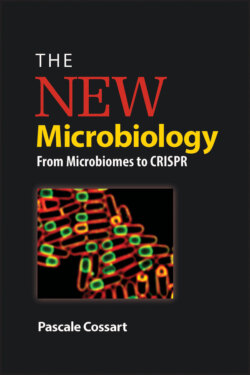The New Microbiology

Реклама. ООО «ЛитРес», ИНН: 7719571260.
Оглавление
Pascale Cossart. The New Microbiology
Table of Contents
List of Illustrations
Guide
Pages
THE. NEW. Microbiology. From Microbiomes to CRISPR
PREFACE
ACKNOWLEDGMENTS
ABOUT THE AUTHOR
CHAPTER 1. Bacteria: Many Friends, Few Enemies
CHAPTER 2. Bacteria: Highly Organized Unicellular Organisms
Mycoplasma
Flagella and other appendages
Bacterial shape and division: proteins similar to actin and tubulin in eukaryotes
CHAPTER 3. The RNA Revolution
Repressors and activators
Noncoding RNAs
Riboswitches: molecular interrupters
RNAIII in Staphylococcus aureus
The excludon
CHAPTER 4. From the CRISPR Defense System to the CRISPR/ Cas9 Method for Modifying Genomes
CHAPTER 5. Antibiotic Resistance. The discovery of antibiotics
Sulfonamides enter the game
Mode of action of antibiotics
Antibiotics in animals
From the first cases of resistance to a global panic
Potential solutions and hopes
Inhibition of quorum sensing
Phage therapy
Bdellovibrio: why not?
CHAPTER 6. Biofilms: When Bacteria Gather Together
Formation and maturation of a biofilm
CHAPTER 7. How Bacteria Communicate: Chemical Language and Quorum Sensing
Interrupting quorum sensing to prevent infection
Suicide—or murder?
Gene transfer: conjugation, transformation, and formation of nanotubes
CHAPTER 8. When Bacteria Kill Each Other
Bacteriocins
Contact-dependent inhibition of growth
Type VI secretion: attack and counterattack
CHAPTER 9. Human-Animal Symbioses: The Microbiotas
The paradigm ofEuprymna scolopesandVibrio fischeri
The intestinal microbiota
Products of the intestinal microbiota
Evolution of the intestinal microbiota over a lifetime
Obesity and metabolism
Microbiota and the immune system
SFB in the intestine
Microbiota, pathogenic bacteria, and dysbiosis
Dysbiosis and fecal transplants
Microbiota and the human diet
Microbiota and circadian rhythms
Skin microbiota
Vaginal microbiota
Intestinal microbiota of termites
Composition of microbiotas: signaling molecules and quorum sensing
Longevity and microbiota
CHAPTER 10. Bacterium-Plant Symbioses: Microbiotas of Plants
Microbes and roots: the underground
Nitrogen fixation: an example of facultative symbiosis
Bacterial communities and the phyllosphere
Nitrogen fixation and root nodule formation
Bacteria and plant growth
CHAPTER 11. Endosymbiotic Relationships
A close-knit couple: the pea aphid andBuchnera bacterium
Other insects and other symbioses
When bacteria control fertility
Bacteria and worms
Bacteria in cell nuclei and mitochondria
CHAPTER 12. Pathogenic Bacteria, Major Scourges, and New Diseases
The great scourges of humanity. Plague and other yersinioses
Yop proteins and type III secretion systems
Leprosy andMycobacterium leprae
Tuberculosis andMycobacterium tuberculosis
Mycobacterial genomics
Childhood diseases. Pertussis and Bordetella pertussis
The diphtheria toxin
Diphtheria and Corynebacterium diphtheriae
Tetanus andClostridium tetani
The tetanus toxin
Streptococci
Streptococci as the basis for historic discoveries
The first complete bacterial genome to be sequenced
Haemophilus influenzae
Meningococci and meningitis
Escaping the host’s defenses and antigenic variation
Listeriosis andListeria
Listeria, an invasive model bacterium
Intestinal infections. Cholera and Vibrio cholerae
Salmonellae: gastroenteritis and typhoid fever
Vibrio cholerae virulence factors
Virulence factors in salmonellosis
Escherichia coli and other coliform bacilli
EPEC and cellular adhesion: the astonishing story of Tir
Health care-related infections. Enterococci
Staphylococci
Virulence factors in enterococci
Pseudomonas aeruginosa
Pseudomonas: burns and cystic fibrosis
Klebsiella species
Sexually transmitted infections. Gonorrhea and Neisseria gonorrhoeae
Chlamydia trachomatis
Diseases of armies
Agents of bioterrorism. Bacillus anthracis
The tripartite protein toxin ofBacillus anthracis
Helicobacter pylori
New diseases. Helicobacter pylori
Borrelia burgdorferi and Lyme disease
Legionella
Clostridium difficile
Dot/Icm type IV secretion systems inLegionella
Diseases prevalent in developing countries. Clostridium botulinum
Shigella flexneri as a model bacterium
Shigellosis and diarrhea in the tropics
CHAPTER 13. The Multiple Strategies of Pathogenic Bacteria
Contributions of molecular and cellular biology
Bacteria that adhere to cells but do not enter them
The first cloning of virulence genes
Invasive bacteria
The benefits of genomics
CHAPTER 14. Pathogenic Bacteria in Insects
CHAPTER 15. Plants and Their Pathogenic Bacteria
Agrobacterium tumefaciens and genetically modified organisms
Phytoplasmas: pathogenic bacteria in plants and insects
CHAPTER 16. New Visions in Infection Defense. Genetic theory of infectious diseases
Health security in the age of globalizing risks
CHAPTER 17. Bacteria as Tools for Research
Restriction enzymes
PCR
The PCR technique
Bacteria and optogenetics
The rhodopsin family
The CRISPR/Cas9 revolution
Using pathogenic bacteria to understand eukaryotic cells
The ActA protein and cellular motility
Discovering the role of the Arp2/3 complex
Bacterial toxins
Nucleomodulins
The TALEN technique
CHAPTER 18. Bacteria: Old and New Health Tools
Bacteria in food
Probiotics
Fecal transplants
The intestinal microbiota of insect vectors
CRISPR/Cas9 and gene therapy
Synthetic biology
Synthesis of valinomycin
CHAPTER 19. Bacteria as Environmental Tools. Bacillus thuringiensisas a biopesticide
Bacillus subtilis to protect plant roots
Wolbachia and biocontrol of mosquito-borne infectious diseases
Replacing wild mosquitoes with Wolbachia carriers
Eliminating carrier mosquitoes
CHAPTER 20. Conclusion
APPENDIX. Major Figures in Microbiology
GLOSSARY
BIBLIOGRAPHY. Preface
PART I:
Chapter 1
Chapter 5
PART II:Sociomicrobiology: The Social Lives of Bacteria. Chapter 6
Chapter 8When Bacteria Kill Each Other
Chapter 9
Chapter 10
Chapter 11
PART III:The Biology of Infections. Chapter 12
Chapter 13
Chapter 14
Chapter 16
PART IV:Bacteria as Tools. Chapter 17
Chapter 18
Chapter 19
PHOTO CREDITS
INDEX
WILEY END USER LICENSE AGREEMENT
Отрывок из книги
Pascale Cossart
.....
It was predicted that the 21st century would be the age of biology. This is indeed the case, and microbiology is at the forefront. In 2012, the French Academy of Sciences, with its sister institutions in England and Germany, the Royal Society and the Leopoldina, held a colloquium titled “The New Microbiology” that met with great success. I have used the same title for this book.
It is now possible to watch bacteria divide and to examine the location, the behavior, or the fate of some bacterial proteins. Indeed, new imaging technologies—particularly time-lapse microscopy and superresolution microscopy, both of which use various fluorescent markers—have made it possible to study bacteria in real time. One can observe the precise location of fluorescently linked bacterial proteins (such as the pole or site of division) and see whether they become more intense or disappear during bacterial growth. Combining these imaging techniques with microfluidics—the study of the flow of microquantities of liquids—allows for the real-time observation of bacterial behavior, for example, during changes in cultures or temperature.
.....